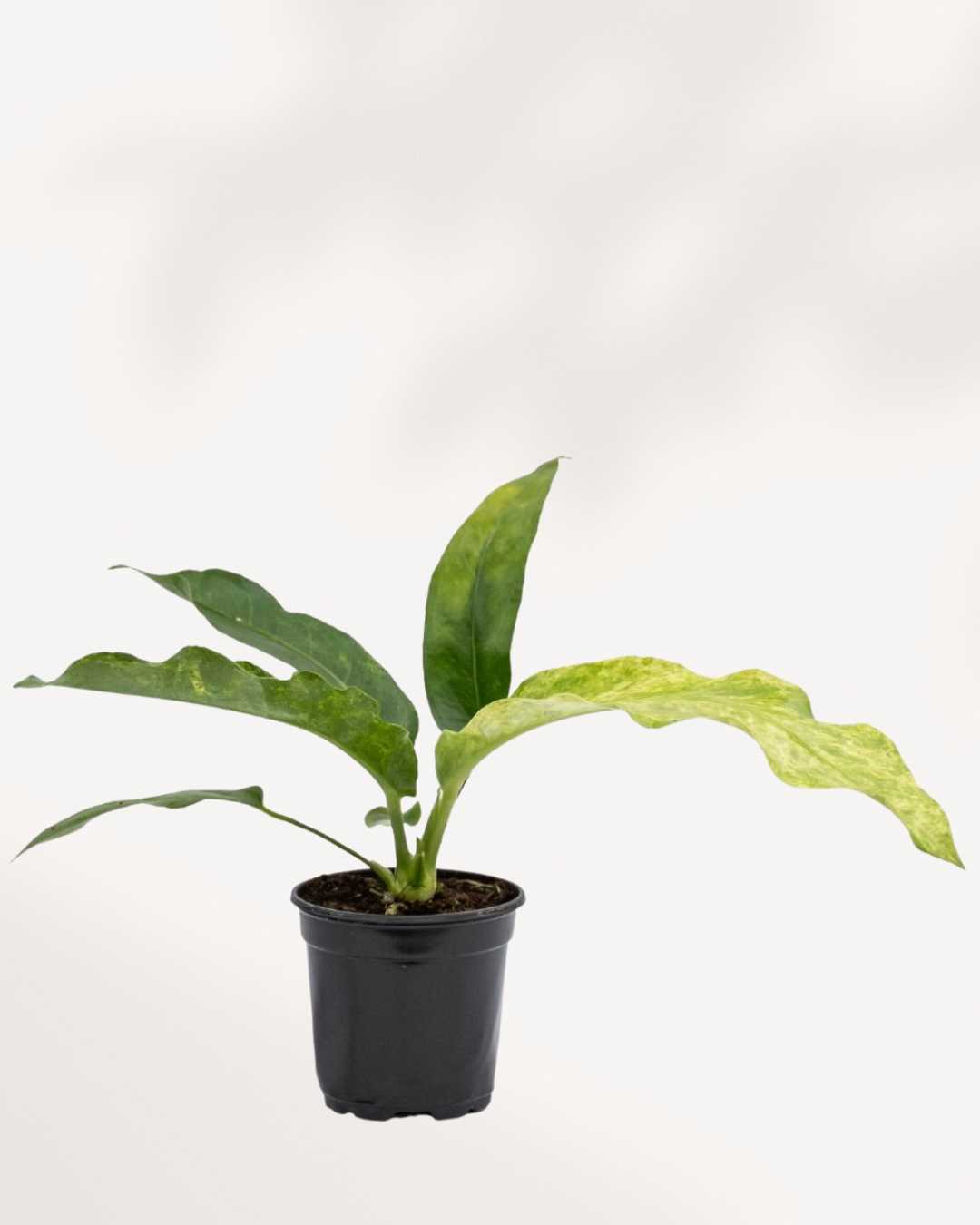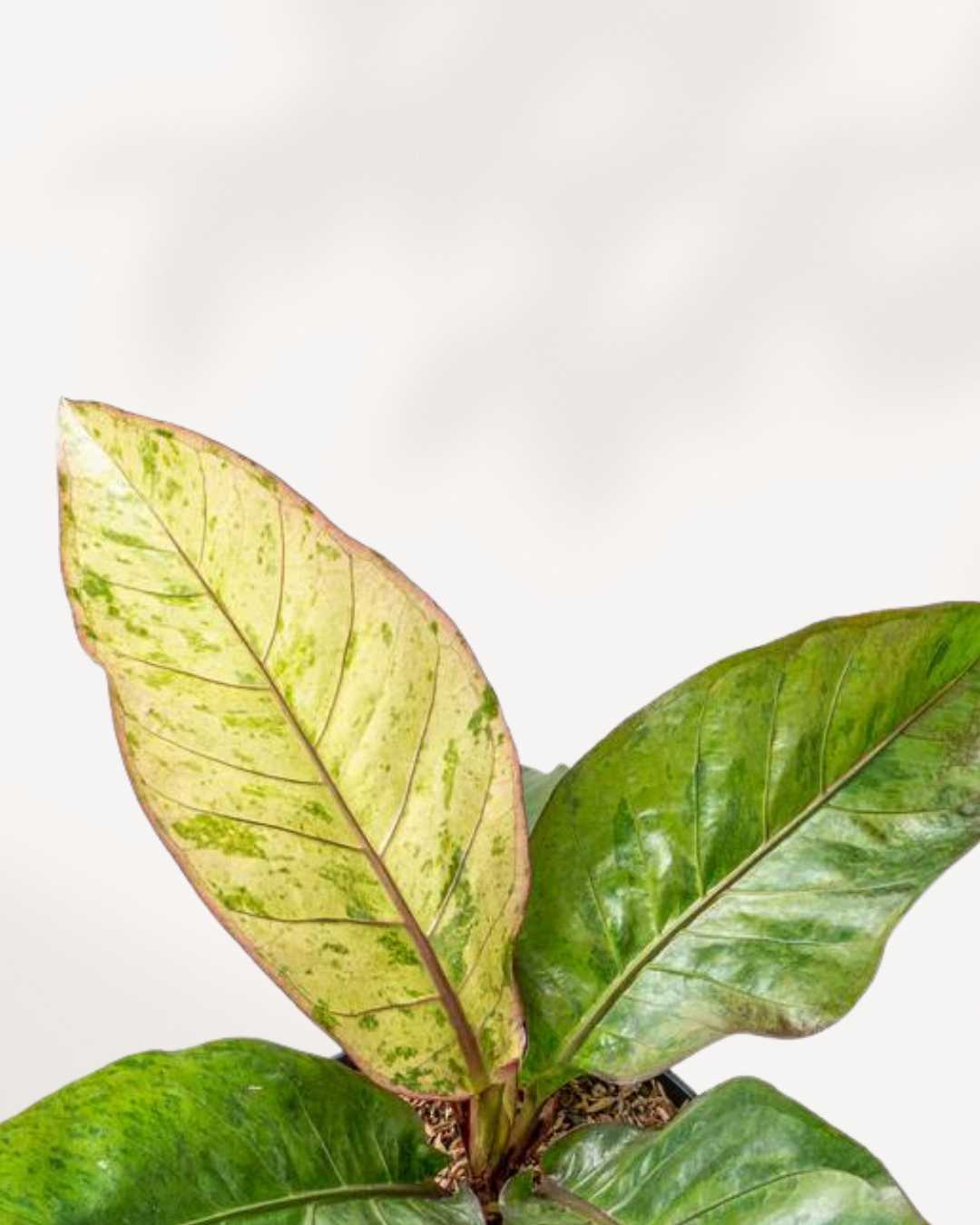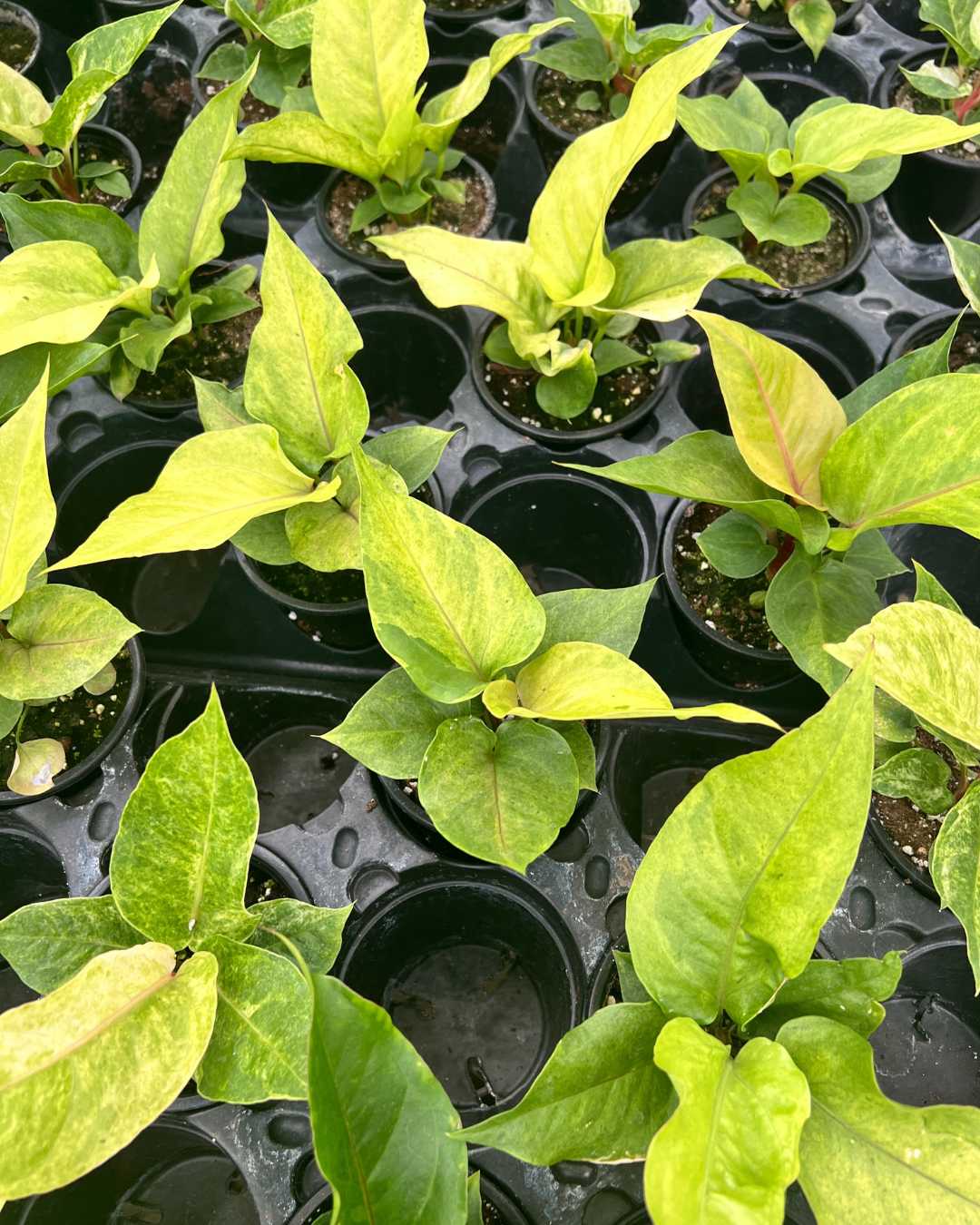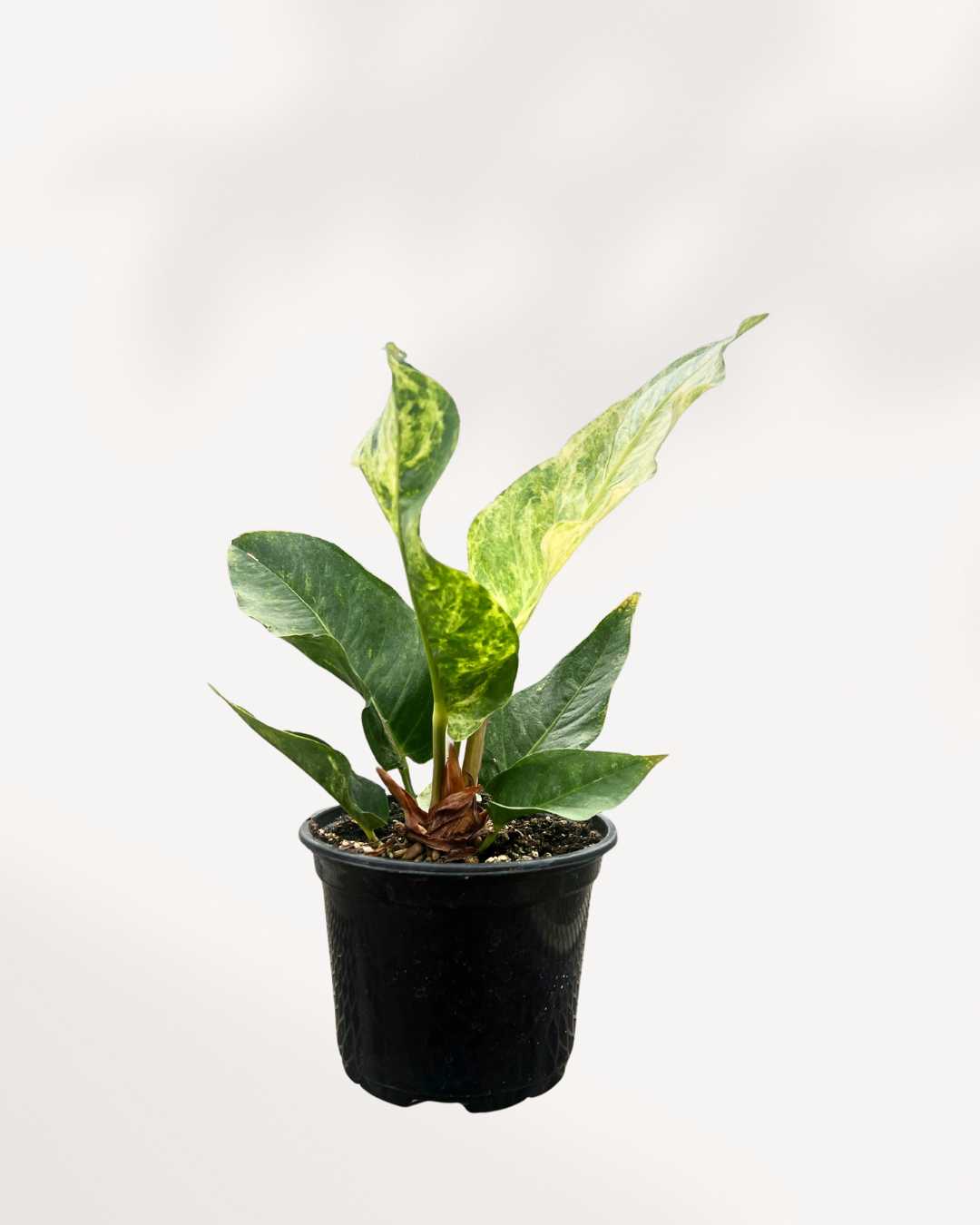Couldn't load pickup availability
Anthurium Hookeri Variegata – Tropical Pattern, Elegant Edge
The Anthurium Hookeri Variegata is a showy, variegated form of the Hookeri anthurium, prized for its glossy leaves splashed with cream or pale green variegation. Compact and architectural, it brings bright, tropical texture to shelves, plant stands, and small floor displays, while rewarding attentive care with steady growth and style.
Why You'll Love Anthurium Hookeri Variegata
✨ Striking variegated foliage that adds instant personality
🌿 Compact, upright habit, great for smaller spaces
☀️ Thrives in bright, indirect light and humid spots
🪴 Excellent for collectors who want unique leaf patterns
Order Yours TodayCommon Names
- Anthurium Hookeri Variegata
- Variegated Hookeri
- Hookeri Variegata
Botanical Classification
- Kingdom: Plantae
- Order: Alismatales
- Family: Araceae
- Genus: Anthurium
- Species: Anthurium hookeri variegata
Where It Comes From
Anthurium species are native to tropical Central and South America, where they live in warm, shaded forest understories. Hookeri varieties prefer humid, sheltered conditions, which is why they respond so well to indoor humidity and bright, indirect light.
Why It’s So Popular
- Unique variegation that stands out in any collection
- Smaller, upright form, easy to style on shelves and stands
- Perfect specimen for enthusiasts who enjoy rare or patterned leaves
- Pairs beautifully with modern interiors and lush plant groupings
Description
Appearance
The Hookeri Variegata displays glossy, lance-shaped leaves with irregular patches or marbling in cream, pale green, or chartreuse. Leaf texture is smooth and somewhat leathery, with short petioles that keep the foliage upright and tidy.
Growth Habit
Typically a compact clumping plant, it reaches a modest size indoors, often staying under 2 feet tall when given bright, indirect light and steady humidity. It fills in nicely as a tabletop specimen or as part of a layered display.
Popular Anthurium Varieties
Anthurium Red
- Classic flamingo-like blooms with glossy red spathes, a dramatic favorite for floral color.
Anthurium White
- Pure white spathes and glossy foliage, elegant and clean in presentation.
Anthurium Pink
- Soft pink blooms that brighten interiors while keeping a gentle aesthetic.
Anthurium Green Lady
- Green spathes and strong foliage, great for collectors who prefer unusual bloom colors.
Dealing with Pests
Spider Mites
Tiny sap-suckers that thrive in dry air, causing stippling and fine webbing. Increase humidity, wipe leaves, and use insecticidal soap or targeted miticide if needed. Read more.
Mealybugs
White, cottony clusters on leaves and stems; remove with alcohol on a cotton swab, or treat with neem oil for persistent infestations. Full guide.
Aphids
Small, soft-bodied insects that cluster on new growth. Rinse with water, apply insecticidal soap, or use neem oil for control. Learn how.
Whiteflies
Small flying pests that leave sticky honeydew. Use sticky traps and regular inspections to catch early outbreaks. Prevention and treatment.
Fungus Gnats
Larvae live in damp soil, causing stress to roots. Let the top soil dry between waterings, use sticky traps, or apply biological controls. Control tips.
Thrips
Slender insects that scar leaves, leaving silvery streaks. Monitor new growth closely and treat with insecticidal soap or neem oil. Management guide.
Scale
Hard, saucer-like bumps on stems and leaves. Gently remove with a soft tool and treat with horticultural oil for severe cases. See details.
Frequently Asked Questions
How much light does Anthurium Hookeri Variegata need?
Bright, indirect light is best. Avoid direct sun which can scorch variegated patches, though a little morning sun behind a sheer curtain is fine.
How often should I water it?
Keep the soil evenly moist, not waterlogged. Water when the top inch feels dry, and ensure the pot drains well to prevent root rot.
Does it need high humidity?
Yes, Anthuriums appreciate higher humidity. Aim for 50 percent or more, using a humidifier or regular misting if your home is dry.
Is Anthurium Hookeri Variegata safe for pets?
No, Anthuriums are toxic if ingested. Keep plants out of reach from curious pets and children.
Learn More About Anthurium Plant Care
For complete care instructions and troubleshooting, visit our Anthurium Plant Care Guide.
Add Patterned Tropical Charm to Your Home
Bring home the Anthurium Hookeri Variegata today for a compact, variegated statement plant that performs beautifully in bright, humid rooms.
Order Yours NowHow to take care of Anthurium Hookeri Variegata
Sun: Indirect
Sun: Indirect
Light: Medium
Light: Medium
Water: When half dry
Water: When half dry
Humidity: High
Humidity: High
Pet Friendly: Caution
Pet Friendly: Caution
Pro Tip
Pro Tip
Delivery Policy for Plant Condition
Delivery Policy for Plant Condition
"I have only received part of my order. What to do?
No worries if you've only got part of your order! Our plants come from different nurseries and might arrive in separate shipments, typically 1-2 days apart. It's all part of ensuring your green friends reach you in top-notch condition!
If you do not receive the remaining packages within 48 hours contact support at info@mygreenscape.ca
What is the Life Time Support?
Absolutely! Lifetime support means you can count on us whenever you have questions or uncertainties about your plant. Whether you're puzzled by its behavior or just want to ensure it's thriving, we're here for you. Connect with us on Instagram @mygreenscapeto or shoot us an email at support@mygreenscape.ca.
When it comes to our guarantee for plants shipped with standard or express, rest assured that we offer a 30-day happy healthy plant guarantee on all such shipments. This ensures that your plants are covered for 30 days after delivery, giving you peace of mind regarding their condition. If you have any concerns within this period, feel free to reach out to us for assistance.
For further details, please visit our Local Delivery, Store Pickup, Standard Shipping Guide Page.
What to expect
What to expect
Your plant will arrive in a standard nursery pot, typically 0.5" - 1" smaller than the stated size to seamlessly fit into your chosen decorative pot. Washable Paper Planter Bags are available for separate purchase.
Just like nature intended, each plant is unique, showcasing natural variations in size, shape, and characteristics. Our commitment is to deliver a plant that closely resembles the one featured on our website, matching your chosen size, and with the potential to thrive happily in your home.
Frequently Asked Questions
Frequently Asked Questions
Certainly! If you're pondering about ordering plants online, you're not alone. We've compiled the most frequently asked questions. Check out our FAQ section here for quick answers! Happy planting!
Plant & Pot Size Chart
Plant & Pot Size Chart
Choosing the right pot size for your plants can be a daunting task, especially if you're new to gardening. But fear not! Our pot sizes chart can help you find the perfect match for your plants, ensuring they have enough space to grow and thrive. With our guide, you'll be able to confidently choose the right pot size and plant variety for your gardening needs.
Plant Pot Size Guide.

| Extra Small | 7-10 cm | 2.5 - 3 inches |
| Small | 11-12 cm | 3.5 - 4 inches |
| Medium | 14-17 cm | 5 - 6 inches |
| Large | 19-21 cm | 8 - 10 inches |
| Extra Large | 24-27 cm | 12 - 14 inches |
All sizes are specified in product details.
Your Complete Guide to Pot Sizes: What Size Should You Choose?

When selecting a pot for your plant, it's important to find the right size. But with all the different options out there, how do you know which one is best? We're here to help!
MyGreenscape's pot sizes chart is a great resource for finding your perfect fit. Our easy-to-read chart takes out all the guesswork and helps you quickly choose the right size for your plant.
Smaller pots are best for seedlings or small plants just starting out. These tend to be shallow but wide, allowing enough room for the roots of the young plant but not too much where they get overcrowded. Medium-sized pots are ideal when your plant has grown from its infancy and is ready for more space. These are deeper and wider than small pots, so that it can accommodate larger root systems - making sure your plant gets enough nourishment while still giving it breathing room. Large pots are top choice if you have an established plant in need of lots of space - think trees and large shrubs! The spacious depth and width allow plenty of room for deep root systems without struggling for air or light.
No matter what size you choose, MyGreenscape has got you covered, with our pot sizes chart guaranteeing you find the perfect fit every time!
Winter Shipping Protection
Winter Shipping Protection
We take extra care with each package during the colder months. For destinations experiencing cold weather, we provide insulated packaging and heat packs as needed to protect your plants from freezing temperatures. With Winter Shipping Protection, your plants are equipped to arrive safe and sound, even in winter’s chill.
Care Guide
Care Guide
Explore essential care tips. check out our Comprehensive Resource for Indoor Plant Care.




WATERING MADE EASY
Check soil moisture before watering and use a potting mix that drains well. It’s the secret to healthy, happy plants!
Hear From Happy Plant Parents.
Who have brought Mygreenscape plants into their homes.


















